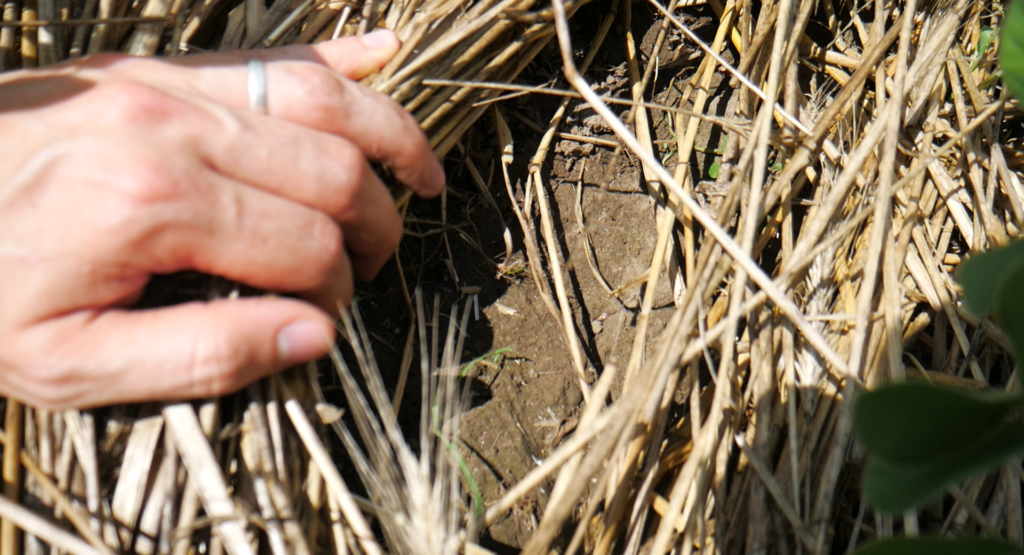First published in Farmtario: https://farmtario.com/crops/lasting-impact-the-secret-to-increasing-carbon-is-in-the-soil/
This article is part two of a three-part series highlighting lessons learned from two long-term crop rotation experiments at the Ontario Crops Research Centres in Elora and Ridgetown.
The evidence is piling up that the corn-soybean rotation – the most common crop rotation in Ontario – performs worse on every metric than diversified rotations with small cereals and cover crops.
But why? Why do diverse rotations perform better?
According to Laura Van Eerd, professor of sustainable soil management in the School of Environmental Sciences at the University of Guelph Ridgetown Campus, “I attribute the resiliency and increases in productivity to increases in soil carbon and nitrogen.”
Back in 2006, OMAFRA Soil Specialists Adam Hayes and Anne Verhallen teamed up with Van Eerd to measure changes in soil carbon and nitrogen levels since the Ridgetown crop rotation experiment was initiated in 1995. They also used the Cornell Soil Health Assessment (CSHA) to get a soil health score for each of the rotations.
“There’s this conception out there that it doesn’t matter which species it is, we just need more of them over time, and that’s what will give us the soil health outcomes that we want. But that’s not a conception that I think is very well supported by the research.”
Dr. Alison King
The results should not surprise: corn-soybean had the lowest soil health scores, the lowest soil carbon levels, and the lowest levels of total soil nitrogen. Diversified rotations with winter wheat had greatest soil health scores, soil carbon and soil nitrogen levels.
Their data also showed that as soil carbon (organic matter) levels increased, crop yields became more consistent year to year. Organic matter reduces soil compaction and waterlogging, allowing crop roots in high organic matter soils to access more water and nutrients, especially during drought years.
At this point in the game it can be tempting to chalk all these benefits up to diversity. But farming is never that simple.
“There’s this conception out there that it doesn’t matter which species it is, we just need more of them over time, and that’s what will give us the soil health outcomes that we want,” says Alison King, a recent PhD graduate from Claudia Wagner Riddle’s agrometeorology lab at the University of Guelph. “But that’s not a conception that I think is very well supported by the research.”
King has been sampling the sister site at Elora, measuring changes in soil carbon under the different crop rotations. And her research echoes what’s been found at Ridgetown: adding wheat and cover crops to corn-soybean rotations increases soil carbon levels and crop yield stability.
But a two-species corn-alfalfa rotation had even higher soil carbon levels than the four-species We’re talking about a paradigm shift on how to build soil organic matter.
“It doesn’t matter so much if there are two species, or three species, or four, or even one. What matters is which species are there,” says King.
The reason these “diverse” rotations perform better than the corn-soybean rotation is all thanks to winter wheat – not some nondescript benefit of “diversity”.
But why wheat? Isn’t it the soybean crop that adds nitrogen to the soil? And isn’t it the corn crop with all the residue it leaves behind that adds soil organic matter?
First, on the nitrogen front, consider that anywhere from five to 20 per cent of the nitrogen scavenged by wheat roots is recycled back to the soil through root exudates or decomposition. And since wheat has such a large, fibrous root system compared to soybeans, that nitrogen is distributed relatively evenly through the soil. According to the Ridgetown plots, this amounts to a 30 pound per acre reduction in the economic nitrogen rate for corn grown in rotations with wheat.
Second, recent research on soil carbon cycling is changing the way we think about building organic matter.
It used to be thought that corn stover and other difficult-to-decompose crop residues made for the greatest increases in soil carbon levels because they were more “stable”. It was typical to see a spike in CO2 coming off the soil after adding green plant materials – an indication of increased microbial activity – which made it appear as though the carbon was being quickly lost with these “labile” carbon sources.
Reality, it turns out, may be the other way around.
“We’re talking about a scientific paradigm shift on how to build soil organic matter,” says Van Eerd.
Researchers are discovering that the burst of microbial activity after adding green plant materials corresponds with a burst in microbial biomass. And when the microbes die and decompose, that microbial biomass is what makes for the greatest gains in soil carbon.
In the case of winter wheat, “you’re having root exudates at different times of the year, at different rooting depths, and that’s stimulating the microbial community,” says Van Eerd.
“It’s the microbial community – their exudates and necromass [decomposed microbial bodies] – that’s really building the soil organic matter.”
This research is funded by Grain Farmers of Ontario (GFO) and the Ontario Ministry of Agriculture, Food and Rural Affairs (OMAFRA), through the Ontario Agri-Food Innovation Alliance. The Ontario Crops Research Centres at Elora and Ridgetown are two of 15 research stations owned by the Agricultural Research Institute of Ontario and managed by the University of Guelph through the Ontario Agri-Food Innovation Alliance, a collaboration between the Ontario Government and the University of Guelph.


